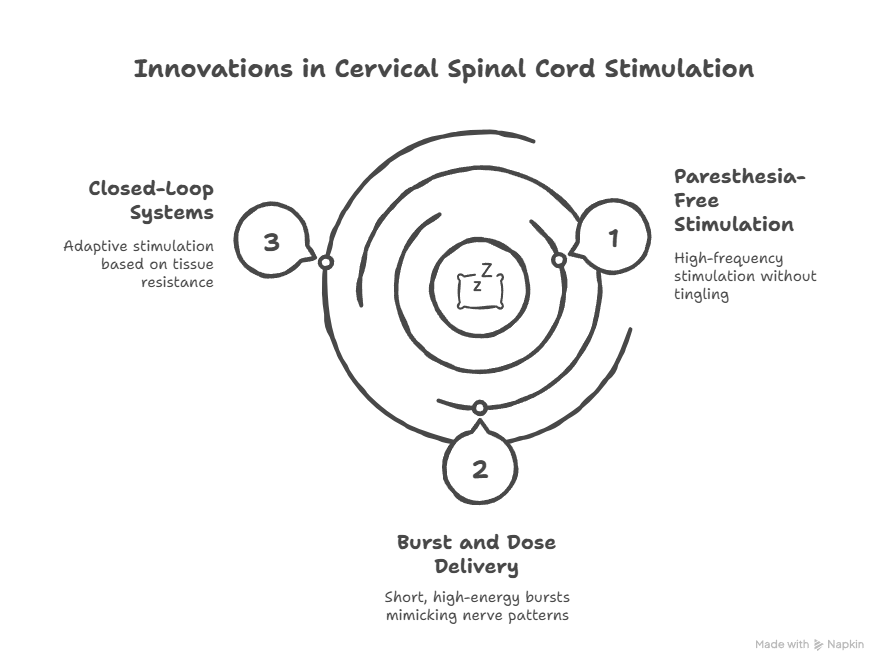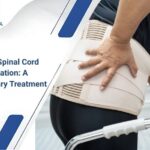If you are reading this, you are likely one of the countless individuals living with chronic, debilitating pain that originates in your neck and often radiates into your shoulders, arms, and hands. This kind of persistent pain, particularly when it’s neuropathic—a deep, burning, shooting, or tingling sensation—is exhausting. You have probably tried everything: endless physical therapy, numerous medications, steroid injections, and perhaps even traditional surgery, only to find that the relief is temporary or non-existent. When conventional options fail, it is easy to feel that you have run out of hope.
But modern neuro-technology is offering a revolutionary answer. For those living with intractable pain, a procedure known as Cervical Spinal Cord Stimulation: A Revolutionary Treatment for Chronic Pain has emerged as one of the most effective and durable solutions available today. It is not a cure for the underlying condition, but it is a powerful tool designed to manage the sensation of pain itself, effectively intercepting the agony before it registers in your mind. This is a game-changer for people who feel their life has been hijacked by persistent discomfort.
Understanding the Challenge: Why Conventional Treatments Fail
Cervical pain arises from the delicate structures of the neck, including the vertebrae, discs, and the intricate network of spinal nerves. Conditions like cervical spondylosis, herniated discs, or nerve root compression are often the culprits. Traditional treatments aim to fix the structural issue (e.g., with fusion surgery) or reduce inflammation (injections).
However, chronic neuropathic pain is often a different beast. Sometimes, even after the structural problem is corrected, the nerves remain “sensitized” or damaged. This can result in conditions like Failed Neck Surgery Syndrome (FNSS) or Complex Regional Pain Syndrome (CRPS) in the upper limbs, where the nervous system itself continues to fire off pain signals long after the initial injury has healed. For these patients, where the pain is generated by the nervous system rather than an identifiable structural source, Cervical Spinal Cord Stimulation: A Revolutionary Treatment for Chronic Pain offers a targeted, non-opioid solution.
What is Cervical Spinal Cord Stimulation: A Revolutionary Treatment for Chronic Pain?
Spinal Cord Stimulation (SCS) is an advanced pain management technique that uses a mild electrical current to change how the brain perceives pain. Think of it as a pacemaker for the nervous system. Specifically, Cervical SCS involves placing thin, insulated wires (leads) into the epidural space—the area just outside the protective membrane surrounding the spinal cord—in the neck region.
- The Mechanism of Action: The leads deliver low-voltage electrical impulses to the spinal cord. These impulses intercept the pain signals that travel from the painful region (e.g., the hand, arm, or neck) up the spinal cord to the brain. By blocking or altering these signals, the SCS system essentially replaces the painful sensation with a much milder, sometimes pleasant, tingling sensation called paresthesia, or, with newer technologies, no sensation at all.
- Targeted Relief: Because the cervical spine controls nerve pathways to the neck, shoulders, and arms, placing the leads in this specific region allows for highly targeted pain relief in the upper body, which is a key reason why Cervical Spinal Cord Stimulation: A Revolutionary Treatment for Chronic Pain is so effective for people suffering from chronic pain in the upper extremities.
Looking for Long-Lasting Relief from Chronic Neck or Spine Pain?
Discover how Cervical Spinal Cord Stimulation can transform your life by reducing chronic pain and improving mobility. Consult Dr. Arun Saroha, a renowned spine surgeon with 25+ years of experience in advanced pain management treatments.
Book a Consultation with Dr. Arun SarohaThe Patient’s Journey: A Two-Stage, Minimally Invasive Process
One of the great advantages of SCS is that it involves a critical “test drive” period, ensuring that the treatment provides significant relief before a permanent system is implanted. This staged approach minimizes risk and maximizes the chances of a successful long-term outcome.
Stage 1: The Trial Period (The Test Drive for Relief)
This is the most crucial step and the ultimate predictor of success for Cervical Spinal Cord Stimulation: A Revolutionary Treatment for Chronic Pain.
- Minimally Invasive Placement: Using fluoroscopic (X-ray) guidance and local anesthetic, the physician (typically a highly skilled neurosurgeon or pain specialist) inserts temporary electrode leads through a needle into the epidural space near the cervical spine.
- The Programming: Once the leads are positioned, the physician works with the patient in real-time to adjust the stimulation. The patient provides immediate feedback, helping the doctor “map” the painful areas and ensure that the stimulation covers all the painful regions in the neck and arms.
- Testing at Home: The patient then goes home with the temporary leads connected to an external battery/generator worn on a belt. This trial usually lasts 5 to 7 days, allowing the patient to test the system during their normal daily activities—sitting, sleeping, moving, and resting.
- Success Criteria: For the trial to be considered a success, the patient must typically report a 50% or greater reduction in their pain levels and a significant improvement in their ability to function and their quality of life. If this threshold is met, the patient is deemed an excellent candidate for the permanent system.
Stage 2: Permanent Implantation (The Definitive Solution)
If the trial is successful, the patient moves on to the permanent implantation of Cervical Spinal Cord Stimulation: A Revolutionary Treatment for Chronic Pain.
- Permanent Leads: The surgeon places permanent, sturdy leads precisely in the same effective location identified during the trial. These leads are secured to prevent movement.
- IPG Implantation: The wires are tunneled under the skin to a small, battery-powered neurostimulator (Implantable Pulse Generator or IPG). The IPG is typically implanted under the skin in a comfortable area, such as the upper buttock or abdomen.
- Minimally Invasive Recovery: The procedure is considered minimally invasive, and the recovery time is much shorter and less complicated than traditional spine surgery. Once healed, the patient uses a small remote control to turn the stimulation on or off, adjust the intensity, and choose from various customized programs to address different types of pain throughout the day.
The Revolution in Technology: Modern SCS Innovation
The reason Cervical Spinal Cord Stimulation: A Revolutionary Treatment for Chronic Pain is now considered revolutionary is due to advances in the technology itself. Modern SCS systems are far more sophisticated and effective than earlier versions, which often only offered the tingling paresthesia relief.

- Paresthesia-Free Stimulation (e.g., High-Frequency/10 kHz): Some of the newest systems deliver electrical pulses at a much higher frequency (e.g., 10,000 Hertz). This high-frequency stimulation effectively blocks the pain signal without producing the tingling sensation (paresthesia) that some patients found bothersome. This is a massive step forward in patient comfort and acceptance.
- Burst and Dose Delivery: Instead of a constant electrical pulse, some systems deliver current in short, high-energy bursts, mimicking the natural firing patterns of nerves. This has proven highly effective at managing deep, burning neuropathic pain, often providing more natural and complete relief.
- Closed-Loop Systems (Adaptive Stimulation): The cutting edge of technology involves closed-loop systems that can sense real-time changes in the electrical resistance of the tissue around the spinal cord (which changes with patient movement). The system then automatically adjusts the current output to maintain a consistent level of pain relief, eliminating the need for the patient to constantly adjust the remote. This level of personalized, automated pain control truly solidifies why Cervical Spinal Cord Stimulation: A Revolutionary Treatment for Chronic Pain is considered revolutionary.
Who is the Ideal Candidate for This Treatment?
Not everyone with neck pain is a candidate for SCS. The procedure is typically reserved for those suffering from chronic, treatment-resistant pain:
- Diagnosis: The pain must be chronic (lasting six months or more) and primarily neuropathic in nature.
- Failed Conservative Treatment: The patient must have exhausted all reasonable conservative therapies, including physical therapy, injections, and medication.
- Failed Surgery: Patients with Failed Neck Surgery Syndrome (FNSS) often find SCS to be the only effective option left.
- Successful Trial: Most importantly, the patient must achieve a substantial reduction in pain (50% or more) and improved function during the temporary trial period.
- Psychological Evaluation: Candidates must undergo a psychological evaluation to ensure they are prepared for the procedure, have realistic expectations, and are free from untreated psychological issues that might complicate the outcome.
Looking for Long-Lasting Relief from Chronic Neck or Spine Pain?
Discover how Cervical Spinal Cord Stimulation can transform your life by reducing chronic pain and improving mobility. Consult Dr. Arun Saroha, a renowned spine surgeon with 25+ years of experience in advanced pain management treatments.
Book a Consultation with Dr. Arun SarohaThe Role of the Expert Neurosurgeon
The success of Cervical Spinal Cord Stimulation: A Revolutionary Treatment for Chronic Pain hinges almost entirely on the accurate and precise placement of the electrode leads. The cervical spine is a highly complex and sensitive area; a few millimeters can be the difference between profound pain relief and a failed procedure.
This demands the expertise of a highly skilled specialist, typically a neurosurgeon or interventional pain specialist with extensive experience in spinal anatomy and minimally invasive techniques. Neurosurgeons, in particular, are uniquely qualified due to their deep understanding of spinal cord dynamics and their ability to navigate the complex cervical structures safely and precisely.
Dr. Arun Saroha is a highly regarded neurosurgeon known for his expertise in complex spinal disorders and advanced neurosurgical techniques. His proficiency in procedures like spinal fusion, disc replacement, and minimally invasive techniques makes him exceptionally well-suited to perform the precise placement required for Cervical Spinal Cord Stimulation: A Revolutionary Treatment for Chronic Pain. Choosing an expert like Dr. Arun Saroha is the surest way to maximize the probability of a successful outcome and long-term relief.
The journey with chronic pain is arduous, but the technology of spinal cord stimulation offers a powerful path back to a functional, enjoyable life. If you have exhausted all other options and are looking for a solution that directly addresses the source of your agony, Cervical Spinal Cord Stimulation: A Revolutionary Treatment for Chronic Pain represents the cutting edge of pain management.
Frequently Asked Questions (FAQs)
Does Spinal Cord Stimulation eliminate the pain completely?
While some patients report near-complete relief, the goal of Spinal Cord Stimulation is typically to achieve a significant reduction in pain—usually 50% to 80%—which allows the patient to dramatically improve their function, reduce reliance on pain medication, and regain their quality of life.
Is the Spinal Cord Stimulation procedure dangerous?
The permanent implantation of the SCS system is a minimally invasive surgery and is generally considered very safe. As with any surgery, there are risks, such as infection or lead migration, but the procedure is performed under strict guidance, and the benefits for chronic, debilitating pain often far outweigh the risks.
Can I have an MRI after the Spinal Cord Stimulator is implanted?
Most modern Spinal Cord Stimulators are conditionally approved for MRI scans. This is a crucial advancement. However, it is essential to check the specific manufacturer guidelines and inform all medical professionals that you have an SCS device before undergoing any imaging test.
How long does the SCS battery last, and what happens when it runs out?
The battery life varies depending on the type of system and the frequency of use. Non-rechargeable batteries may last 2-5 years, while rechargeable batteries can last for 7-10 years or more. When the battery depletes, a minimally invasive procedure is required to replace the battery (IPG) only.
What is the difference between a Spinal Cord Stimulator and a Pain Pump?
A Spinal Cord Stimulator (SCS) uses mild electrical current to block pain signals before they reach the brain. A Pain Pump (Intrathecal Drug Delivery System) delivers pain medication (usually a highly concentrated opioid) directly to the spinal fluid, requiring a much smaller dose of medication than oral intake. They treat pain in fundamentally different ways.
If the permanent system is implanted, can it be removed later?
Yes, one of the key advantages of Cervical Spinal Cord Stimulation: A Revolutionary Treatment for Chronic Pain is that the therapy is fully reversible. If the system is no longer needed or if the patient prefers it to be removed, the leads and the neurostimulator can be surgically removed with minimal long-term effects. This reversibility offers a high degree of comfort and security to potential candidates.
When seeking a definitive end to chronic, life-limiting neck and arm pain, the focused expertise of a world-class neurosurgeon is your greatest asset. Dr. Arun Saroha is dedicated to offering cutting-edge solutions, including the nuanced programming and precise placement required for Cervical Spinal Cord Stimulation: A Revolutionary Treatment for Chronic Pain.
Looking for Long-Lasting Relief from Chronic Neck or Spine Pain?
Discover how Cervical Spinal Cord Stimulation can transform your life by reducing chronic pain and improving mobility. Consult Dr. Arun Saroha, a renowned spine surgeon with 25+ years of experience in advanced pain management treatments.
Book a Consultation with Dr. Arun Saroha









